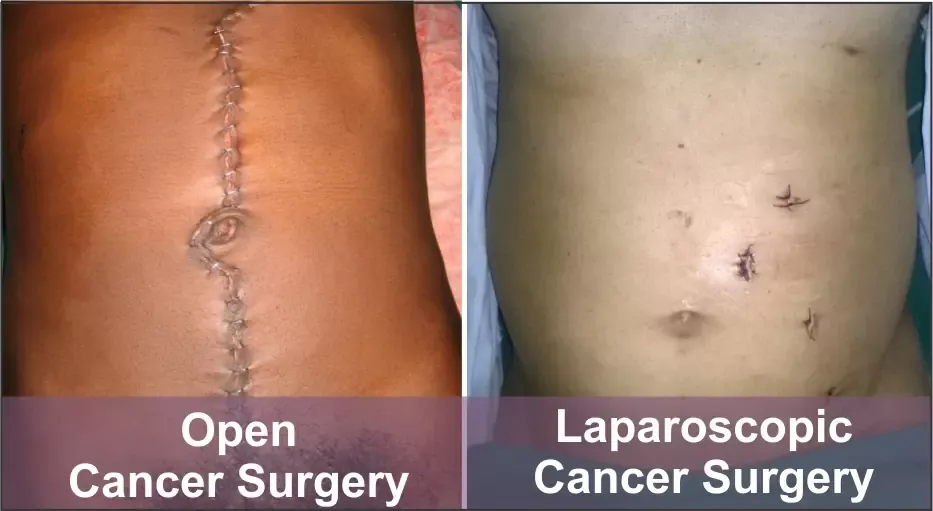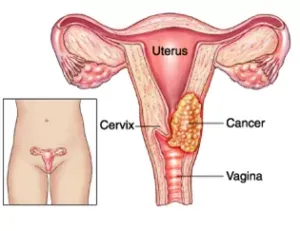Cervical Cancer Treatment in Bangalore
Cervical cancer surgery (Radical Hysterectomy or Wertheim’s Operation) can be performed by conventional open method or by laparoscopy. Laparoscopic or Laproscopic cancer surgery has several advantages over conventional open surgery with same cure rate. Only surgery is curative in most of the cancers. Additional therapies (chemotherapy & radiotherapy) are mostly supportive. But, many patients and their relatives try to avoid surgery for the fear of the immense trauma for their loved ones, resulting in patient getting wrong or less effective treatment. With laparoscopy the trauma is much less and makes the treatment more acceptable. The Team MACS precisely addresses all these issues and works relentlessly for a better life.

Dr. Sandeep Nayak

MBBS, MRCSEd, DNB (Gen Surg),
MNAMS (Gen Surg), DNB (Surgical Oncology),
Fellowship in Laparoscopic and Robotic Onco-Surgery.
Dr Nayak is one of the leading senior Surgical Oncologists (cancer surgeon) of Bangalore. He is one of the pioneers of Laproscopic (laparoscopic) cancer treatment (surgery).
The Advantages Of Robotic & Laparoscopic Cancer Surgery Include

Least Pain and Discomfort

Less Blood Loss

Least Pain and Discomfort

Avoid Unnecessary Major Surgery

Quick Return to Normal Life and Work

Get All the Advantages of Robotic Surgery

Better Vision Quality for the Surgeon

Better Preservation of Pelivic Nerves maintaining the Sexual & Urinary Functions

Cosmetically better (Smallest Wound and Scars)

Least Wound Complications, Less Risk of Wound Infections After Colostomy.
What Is Cancer Of Uterine Cervix ?
Cancer of uterine cervix are usually squammous cell carcinomas and rarely adenocarcinomas. These affect most commonly between 30-45 years of age group and are commoner in Asia and Africa. Most of these are related to infection by a virus (Human Papiloma Virus; HPV). The risk of this cancer can be reduced using a vaccine. Cervical cancer can also be detected in pre-cancer stage by simple test called PAP smear (refer to cancer prevention).

Symptoms And Diagnosis
Fill Out the Form Below
Staging & Treatment
Management of cancer of cervix depends on the stage of the disease. All modalities (surgery, chemotherapy and radiotherapy) of treatment are used to manage the disease effectively.
Stage 0
This is pre-cancer stage where the cancer cells are limited to the surface layer of the cervix. Treatment depends on the need to preserve fertility. For those who plan future pregnancy, the options include cryosurgery, laser surgery, loop electrosurgical excision procedure (LEEP/LEETZ), and cold knife conization. Each of these procedures (surgeries) have their advantages and disadvantages that will be discussed you by your surgeon. When woman in concern does not desire to be pregnant in future or has gone through manopause, the best treatment is surgical removal of uterus (hysterectomy). This surgery can be performed laparoscopically with several advantages to the patient.
Stage IA
At this stage the cancer has invaded beyond the surface layer of cervix into its substance, but, has not reached outside the cervix. The diameter of the disease is not more than 7mm in width and invading no deeper than 5 mm. This stage is further divided into stage IA1 & IA2. The management between the two groups varies slightly and your surgeon will discuss this with you.
Broadly, for this stage you have 4 options:
- Standard of care is radical hysterectomy along with removal of lymph nodes in the pelvis (Radical Hysterectomy or Wertheim’s Operation). This surgery can be performed laparoscopically with several advantages to the patient. (laparoscopic radical hysterectomy).
- If you still want to be able to have children (early disease only), first the cancer is removed with a cone biopsy, and then you are watched closely to see if the cancer comes back. If the cone biopsy doesn’t remove all of the cancer (or if you are done having children), the uterus will be removed (laparoscopic hysterectomy).
- Internal with or without external beam radiation therapy to the pelvis
- Radical trachelectomy with removal of pelvic lymph nodes can be done if you still want to be able to have children.
If the cancer is found in any pelvic lymph nodes during surgery, some of the lymph nodes that lie along the aorta (the large artery in the abdomen) may be removed as well. All tissue removed at surgery will be examined microscopically. Further treatment is based on the results of the microscopy findings.
Stage IB
The disease is larger than stage IA, however, has not spread outside the cervix into vagina or pelvis. This stage is further divided in to B1 & B2 based on the size of the disease. Stage B2 includes all cases that are larger than 4cm in diameter and whereas, smaller ones are categorized as stage IB1.
Stage IB1: There are 3 options available:
- The standard treatment is a radical hysterectomy with removal of lymph nodes in the pelvis (Laparoscopic Radical Hysterectomy or Wertheim’s Operation) and sometimes from higher up in the abdomen (called para-aortic lymph nodes). This surgery can be performed laparoscopically with several advantages to the patient.
- The second treatment option is radiation therapy. Laparoscopic pelvic lymph node dissection before this can increase effectiveness of this treatment.
- Radical trachelectomy with removal of pelvic (and some para-aortic) lymph nodes is an option if the patient still wants to be able to have children.
Stage IB2
There are 3 options available
The standard treatment is the combination of chemotherapy and radiation therapy.
- Another choice is radical hysterectomy (Laparoscopic Radical Hysterectomy or Wertheim’s Operation) with removal of pelvic (and some para-aortic) lymph nodes. If cancer cells are found in the lymph nodes removed, or in the margins, radiation therapy may be given, possibly with chemotherapy, after surgery.
- Some doctors advise radiation given with chemotherapy (first option) followed by a laparoscopic hysterectomy. Laparoscopic pelvic lymph node dissection before radiotherapy can increase effectiveness of this treatment.
Stage II
It is divided into stage IIA and stage IIB
Stage IIA: The cancer is extended into upper 2/3 of vagina. Treatment for this stage depends on the size of the tumor.
- One choice for treatment is internal (brachytherapy) and external radiation therapy. Some experts recommend removing the uterus after the radiation therapy is done. Laparoscopic pelvic lymph node dissection before this can increase effectiveness of this treatment.
- If the cancer is not larger than 4 cm, it may be treated with a laparoscopic radical hysterectomy and removal of lymph nodes in the pelvis (and some in the para-aortic area). If the tissue removed at surgery shows cancer cells in the margins or cancer in the lymph nodes, radiation treatments to the pelvis will be given with chemotherapy.
Stage IIB: The cancer is extended into the tissue next the uterus but not reached the wall of the pelvis. Combined internal and external radiation therapy along with chemotherapy is the usual treatment. Laparoscopic pelvic lymph node dissection before this can increase effectiveness of this treatment.
Stage III and IVA: Combined internal and external radiation therapy given with chemotherapy is the recommended treatment. Laparoscopic pelvic lymph node dissection before this can increase effectiveness of this treatment especially when the nodes are positive.
Stage IVB: At this stage, the cancer has spread out of the pelvis to other areas of the body. Stage IVB cervical cancer is not usually considered curable. Treatment options include radiation therapy to relieve the symptoms of cancer that has spread to the areas near the cervix or to distant sites (such as the lungs or bone). Chemotherapy is often recommended.
Recurrent Cervical Cancer
Cancer that comes back after treatment is called recurrent cancer. Cancer can come back locally (in the pelvic organs near the cervix) or come back in distant areas. If the cancer has recurred in the pelvis only, extensive surgery (pelvic exenteration) may be an option for some patients. This surgery can be performed laparoscopically with several advantages to the patient. This operation may successfully treat 40% to 50% of patients. If surgery is not feasible, radiation or chemotherapy may be used for palliative treatment (treatment to relieve symptoms but not expected to cure). If your cancer has recurred in a distant area, chemo or radiation therapy may be used to treat and relieve specific symptoms.
Fill Out the Form Below
Cervical Cancer In Pregnancy
If the cancer is stage IB or higher, it is preferable to terminate pregnancy and treat cancer according to stage. The continuation of pregnancy can only be done after discussing the risks involved.
Further Reading

